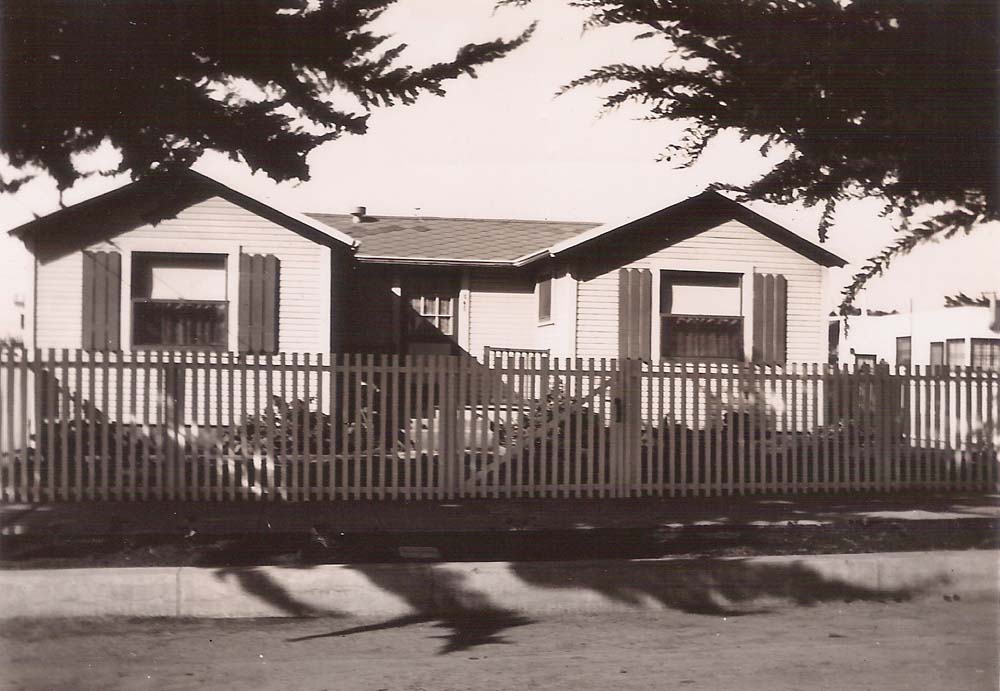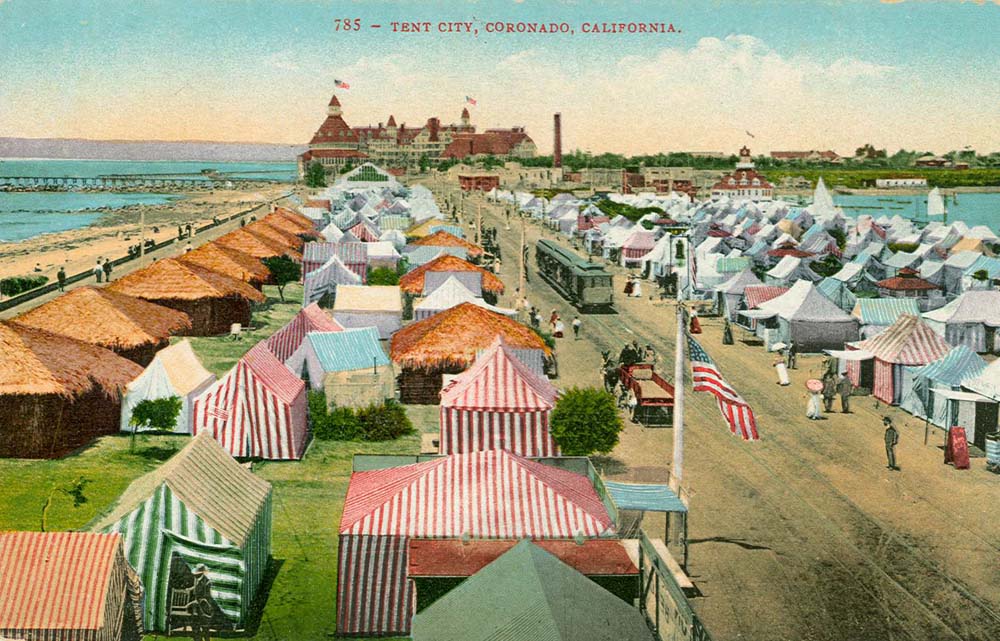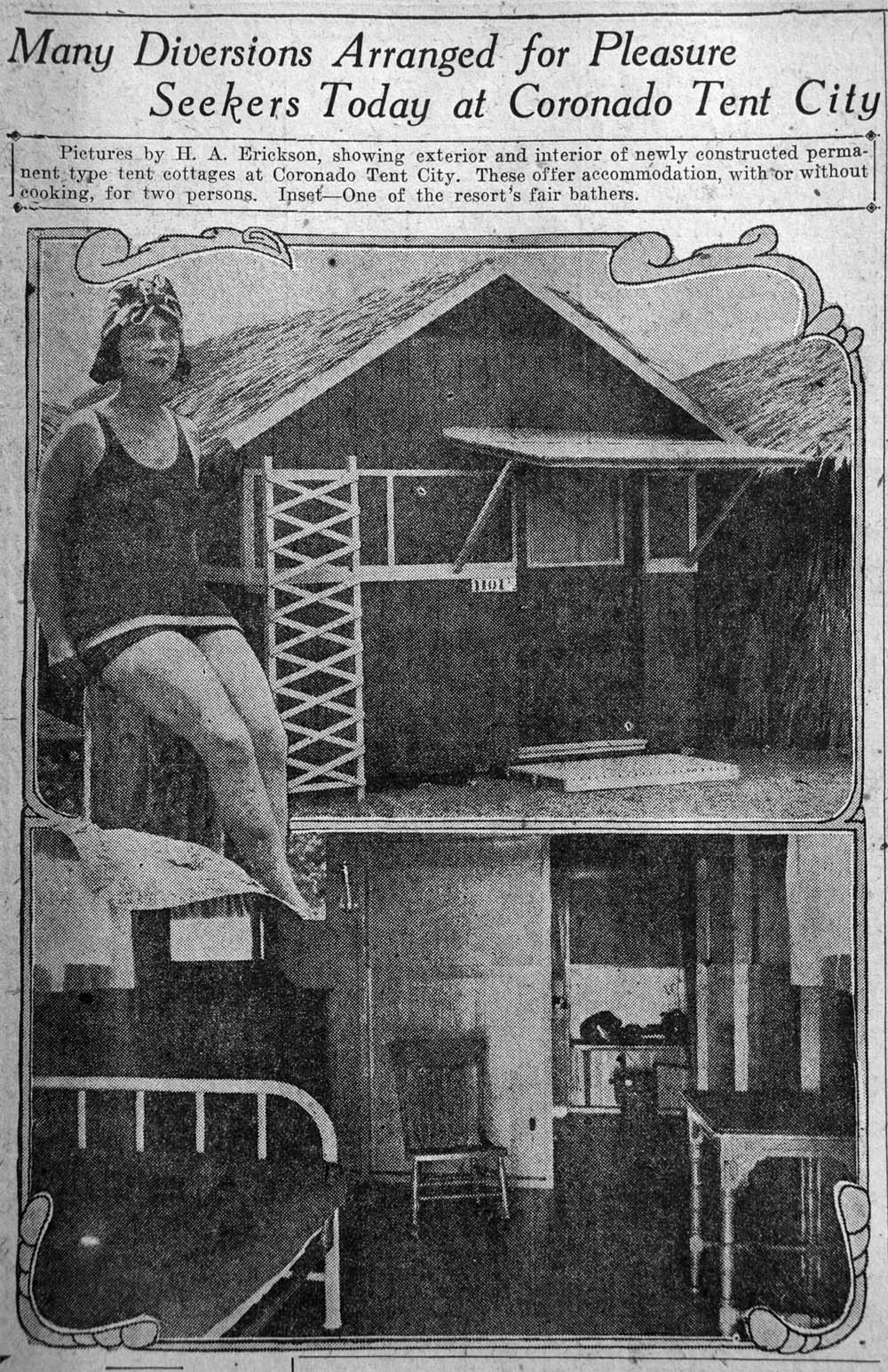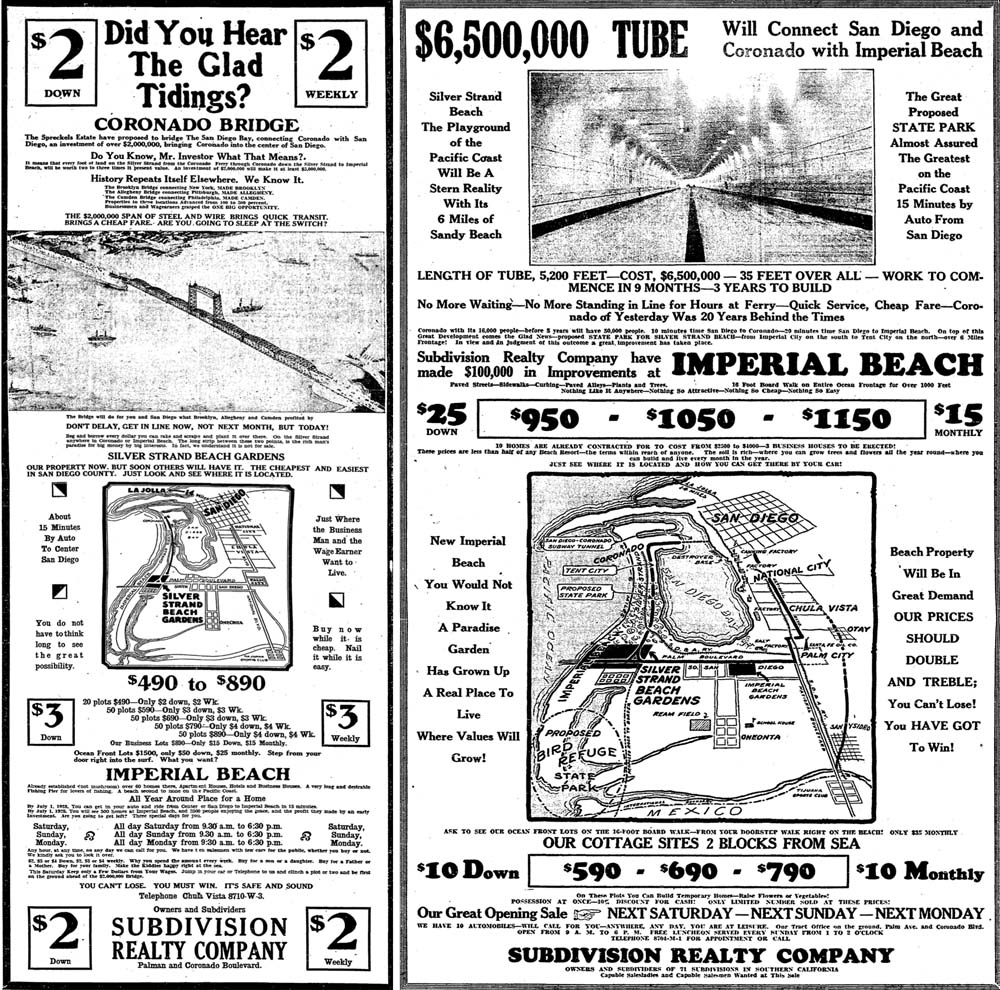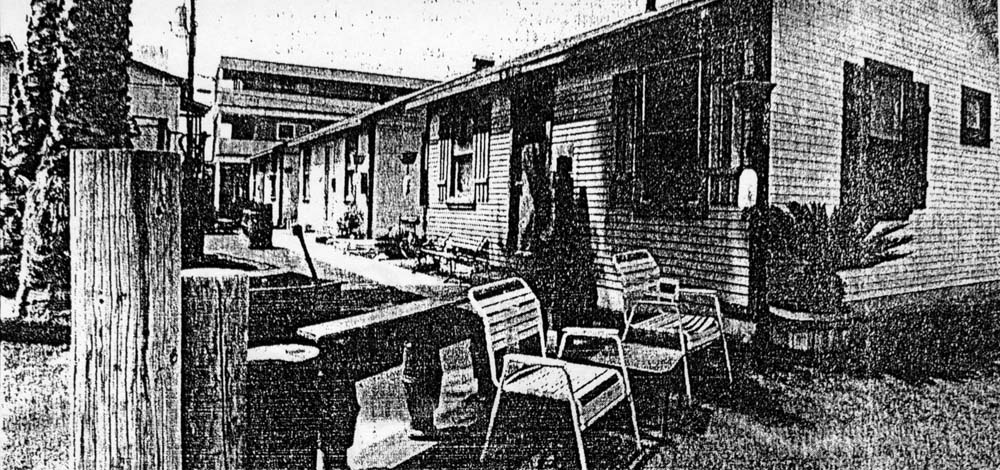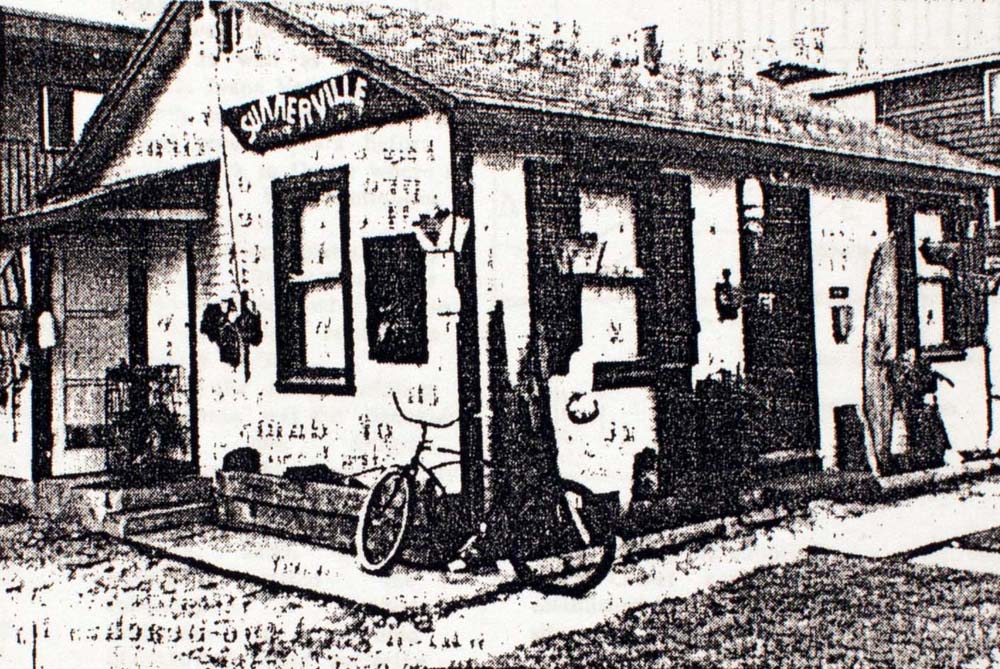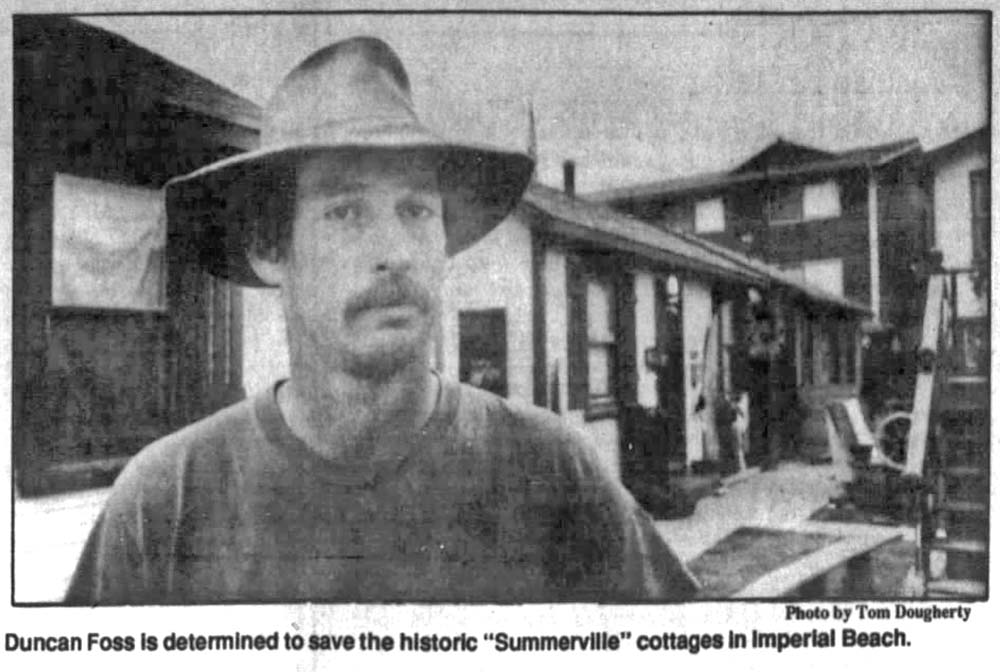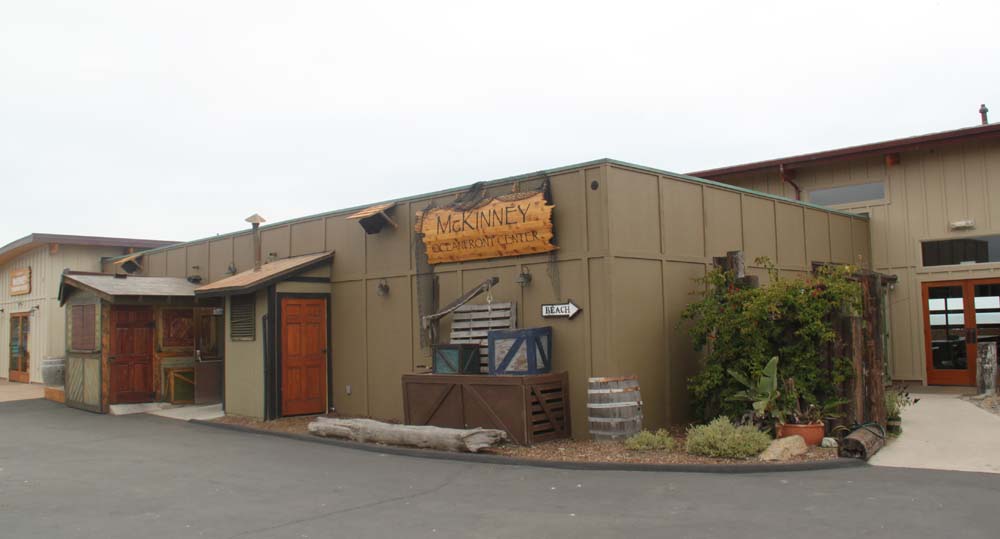|
From Tent City to Imperial Beach
The house at 260 Dahlia Avenue was one of a group of houses moved from Tent City to the Silver Strand Beach Gardens subdivision in Imperial Beach. It was purchased in 1943 for $2750 by Bridie Kilburn, grandmother of the current owner James F. Smith. The nearby homes at 184 and 243 and 251 and 252 Dahlia are similar in appearance and were most likely moved from Tent City at the same time as 260 Dahlia Avenue. (1943 photo from David Smith)
In 1939 several hundred cottages from Coronado's Tent City were moved by barge from the Silver Strand to Imperial Beach. Some of them were meant to become the center of a Writers' Ranch Colony being established by Thomas Halbert Hall. Some of them were moved to the beach and became known as the Summerville cottages. The house at 260 Dahlia Avenue survives today as one of these Coronado Tent City cottages. It was purchased in 1943 by Charles and Bridie Kilburn. After Bridie died in 1981, it was sold to her son James F. Smith (by her first marriage to George Smith) who has lived in the house since 1981. Several other homes on Dahlia are similar to the Smith house and were part of Hall's Colony. The Summerville cottages on the beach at 652 through 664 Seacoast Drive were demolished in 1991, but one was saved and moved to the YMCA Camp Surf where it has been incorporated into the McKinney Oceanfront Center.
Tent City postcard ca. 1910
In 1900 John D. Spreckels established Tent City, originally known as "Camp Coronado," in the Strand just south of the Hotel. "A summer campground, it provided tents available for rent and offered such attractions as a large bath house, the open plunge with a sand bottom and a restaurant. Events had already been scheduled so that people could vacation even for weekends. A booklet-type circular, the Tent City News, served as a type of newspaper, and carried programs about the band conceits, water sports events, hours of Sunday church services, news of visitors, and some advertisements. Spreckels always had the larger picture of his business ventures. He related one business to another. Tent City to him was a place to adventure, and rest, but at the end of all of his transportation lines. Originally, it was said, Tent City was a joint business venture between the Spreckels interests and a Los Angeles tent-and-awning manufacturer named "Swanfeldt." Whose name was stenciled on the tents. There was a choice of white, or red and white striped, ranging from family size to a small single. All tents had wooden floors and were furnished. Each had one bedstead or more, a three-legged 'spider' for a wash basin and pitcher, a dresser, and a chair. If cooking facilities were wanted, a kerosene stove was set up in a "cook tent" in the rear for an extra $5.00 a month-complete with a few pots, some crockery, and flatware-but no guarantee against fire. Most tents rented for $4.50 per week at that time. The San Diego Union of January 1, 1901, reported that over 500 persons lived in the tents during the past season, and 68,139 people attended the evening concerts, dances and other attractions. The advertising of Camp Coronado was thorough, and systematically done by the Santa Fe Railroad and the Coronado Beach Company. Each year, Tent City opened its season with more attractions and improvements. Down the center of Tent City ran Main Street which was paralleled by Ocean Front and Bay Front, intersected by numbered streets. At each corner of Main Street was a big white barrel with a spigot, kept filled with ice, making ice water. In the center of each block was a community sink for dishwashing and some laundering. Tubs of water were put at various places in which to wash off sandy feet The novel feature for the summer of 1901 was the "Floating Casino," in reality, the ill-fated Silver Gate ferry moored in Glorietta Bay. A fairy-like bower of flowers and palms, it had electric lights, and music supplied with a regular orchestra. On decks one could enjoy an ice cream parlor, rest and reading rooms, a dance hall and casino, a small stage for theatrics, and church services every Sunday!" (Coronado The Enchanted Island, pp 90-91 ) In Tent City in 1923, the thatched roofed cottages were stripped of their palm leaf toupees and given permanent roofs. Wooden sides on the houses were built three quarters of the way up with canvas drops which could be rolled up or down. The intent was to provide for a permanent winter population. (Coronado The Enchanted Island, p. 181 )
"Pictures by H. A. Erickson, showing exterior and interior of newly constructed permanent-type tent cottages at Coronado Tent City. These offer accommodation, with or wfthout cooking, for two persons. Inset, one of the resort's fair bathers." (The San Diego Union, June 14, 1925)
Silver Strand Beach Gardens advertised in The San Diego Union, Sept. 17, 1926, and Feb. 23, 1929.)
In 1926 the subdivision known as Silver Strand Beach Gardens was established in Imperial Beach by B. B. Margolis with the promise of a quick connection to San Diego up the Strand and through Coronado to a future tunnel or bridge across the bay, as promised in these advertisements of Sept. 17, 1926 (left, click for larger view) and Feb. 23, 1929 (right, click for larger view). Many of the Tent City homes that were moved in 1939 were located in Silver Strand Beach Gardens. 1939/05/05 - WRITERS' H(E)AVEN T0 BE ERECTED AT IMPERIAL BEACH. A permit to move 170 cottages from Coronado was granted today by the state highway department to Thomas Halbert Hall, manager of the Writers' ranch. Hall received a modest fortune from the late Minnie J. Douglass to provide a home for writers who could not be self-supporting from their journalistic effort. The houses are to be remodeled at an expense of $20,000 and located at Imperial Beach, where Hall has bought 200 lots. Income property, consisting of a $40,000 apartment building, is being constructed to finance the Imperial Beach colony. Hall has taken out a house-moving license and intends to buy 300 cottages for the colony. ( San Diego Union, May 5, 1939. ) 1939/05/10 - Thomas H. Hall moved 26 tent houses to Imperial Beach. (The San Diego Union, May 10, 1939.) 1939/05/12 Local Realtor Sells Property To "Writers' Ranch" Colony Harry Miller, local realtor sold 25 lots and a furnished house .Saturday in Imperial Beach, which will be added to the property already owned by the Writer's ranch. Thomas Halbert Hall, former chauffeur of the late Minnie J. Douglass has a modest fortune at his command with which to purchase lots and erect homes for writers who could not be self supporting from their journalistic efforts. Hall is author of several text books, and was appointed by his late, employer to oversee the establishment of a ranch for writers. Hall has received a permit to move 170 cottages from Tent City in Coronado and work of this project is well underway. The houses are to be remodeled at an expense of $20.00. Hall has already purchased 200 lots for the ranch, and has announced he plans to erect 300 cottages for the colony, and later a $40,000 apartment building for income property. ( The Chula Vista Star, May 12, 1939, Page 7. ) During the 1930s, the Michigan Investment Company moved houses away from Tent City in Coronado. Paul Smith returned home from work one day and to his dismay found two "Tent City" houses had been placed on empty lots he owned between his home and Palm Avenue. "The houses were set on blocks, and the workmen were busily digging cesspools," said Smith. "The workmen informed me that the houses had already been sold. I gave them 24 hours to remove the houses." Apparently, the movers had unloaded the houses on the wrong lots. (Walke, Imperial Beach, 2006, p. 21. )
The last Summerville cottage. (San Diego Tribune Sept. 6, 1961)
1961/09/06 - Imperial Beach buildings make wave. Preservationists seek to determine structures historical value. The Summerville Cottages, which are in disrepair and were vacated on the orders of the city of Imperial Beach, may have historic significance. Are the seven buildings along Imperial Beach's coast an eyesore, a threat to public safety or a misplaced part of Coronado's history? That's the problem local historians and the owner of the property have to wrestle with, and the city of Imperial Beach is determined not to get involved. The buildings, known as the Summerville Cottages, have been in such a state of disrepair that the city ordered them vacated earlier this summer. On Wednesday the council gave the owner, San Diego attorney Dennis White, until Dec. 3 either to repair them or to tear them down. The council ordered them boarded up in the meantime. White, in his appearance before the council, said the property is being sold and is now in escrow. But some local preservationists have entered the fray and given a new twist to what would seem to be a simple question about' the buildings' condition. .They say most of the buildings may be historic structures that were originally sited in Coronado, buildings that were part of the Hotel del Coronado complex. An attorney for the preservationists, Steven W. Haskins, said in a letter to the council that "six of the structures on the. site may very well be original Coronado Tent City cottages from the 1890s. Research now being performed at the San Diego Historical Society. Coronado Historical Society indicates that these structures may have been brought down from Coronado to Imperial Beach and placed at their present location sometime in the early part of this century. The tent city served as a lower-cost annex to the hotel complex during the summer and was made up of more lightly built structures. Haskins said in his letter that the tent city "represents a historically significant milestone in San Diego history. Unfortunately, most all of the structures from the tent city era have been either destroyed or demolished over the years, leaving very few examples for possible study and rehabilitation." Haskins, who has in the past represented anti-development activists, said that "should the structures be found by original Coronado Tent City, then the structures and the site will be inventoried with the California State Office of Historic Preservation for the purpose of achieving historic recognition." That would also trigger a procedure that could slow any future development on the site. Any proposed demolition of buildings there which would "eliminate important examples of major periods of California history," as defined by state law, would require an environmental impact statement. Such a report is sometimes lengthy and often expensive to produce. Imperial Beach, for its part, is staying out of the fray over whether the buildings have historical significance. White said he doesn't know anything about the history of the structures, but activists say they will determine whether the buildings are from the tent city. Attempts by Councilwoman Goethe to get the city involved in the determination of the buildings' history have met resistance. Mayor Michael Bixler, reports that said the buildings are not safe and unfit for human occupation. ( San Diego Tribune, Sept. 6, 1961. )
The last Summerville cottage. (Imperial Beach Times, Nov. 1-14, 1991)
1991/09/07 - Cottages in IB face demolition. History clashed with public safety and lost as the City Council prepared the way for the demolition of several beachfront cottages. The council declared the rental units at 652 through 664 Seacoast Drive "substandard housing" and a public nuisance. Owner Dennis White must board up the buildings and has until Dec. 3 to either correct the structures' deficiencies or demolish them. The cottages, according to former resident Barbara Ann Selke in a letter to the City Council, were brought from Coronado to Imperial Beach during the 1930s and 1940s. The "oneand two-story 1880-type houses, with the 11-foot ceilings", as they were described in an accompanying newspaper article, have "all the charm and diversity of the old Imperial Beach," Selke said in her letter. She said they should be repaired "as a living part of Imperial Beach's history," The buildings were inspected in response to a complaint filed on May 9 and were found to have electrical violations. An interior inspection made a month later uncovered interior defects, including a lack of screens, heaters, smoke detectors and kitchen exhaust fans, illegal wiring, insect infestation and some structural problems. White told the council that he had shut off gas and electrical service in response to a previous City Council request and that the unoccupied buildings are being watched by a full-time custodian who keeps out trespassers. He asked the city to take no action on the matter until the properly, which he said was in escrow, could be transferred to a new owner "As long as it doesn't interfere with your business," he said, "I don't see why you should interfere with mine. These buildings aren't doing anybody any harm, and they aren't even an eyesore. "It would be foolish to put a lot of money into the property if the new owner is going to tear it down," White added. "To bell me to fix them or tear them down is not within the province of the City Council." Duncan Foss, who manages the Summerville cottages, urged the council to vote against demolition. ( Chula Vista Star-News, Sept. 7, 1991, Page 5. )
(from The Chula Vista Star-News, Sept. 18, 1991.)
1991/09/18 - Resident mounts all-out effort to save 'Summerville' cottages. (By Tom Dougherty.) Duncan Foss is a man with a mission. The Coronado native is trying to save a group of 60-year-old cottages that he says are a major part of South Bay history. He is worried that the "Summerville" cottages may be bulldozed as early as this week. So Foss is working with a lawyer to challenge a recent city decision to have the buildings demolished if they are not repaired by December. His attorney, Steven Haskins, claims that the city must prepare an Environmental Impact Report before it can allow a historical building to be torn down. While the cottages have not been declared historical sites, Poss does not doubt their historical significance. The "Summerville" cottages, according to Poss, were built during the 1930s on what is now known as the Silver Strand. They may have been part of the tent city, which stretched about three quarters of a mile south from the Hotel Del Coronado, until they were put on barges between 1940 and 1943 and floated south to Imperial Beach, Foss said. The cottages were called "Summerville" because the South Bay community was largely a place where farm workers from the Imperial Valley spent their summer vacations, Foss said. During the '40s, '50s and '60s the cottages were home to thousands of people who came to escape the sweltering heat of the Imperial Valley and Arizona. Vacationers also cane from as far away as New Jersey, Foss added. Foss first lived in one of the cottages while he was in high school. "It was always an interesting place," he said of the eight wood frame buildings clustered around a central courtyard. He pointed to a cracked concrete ring on the lawn between the two rows of cottages and said that the fire never went out during the summer. "Everybody met here at night and we cooked out and had a good time," Foss said. One time, the lawn had gone fallow so the manager, Dave Francis, drove to Nestor and came back with a truck load of manure, Foss said. "We put the seed down one day and covered it with three inches of manure," Foss said. "Later that night two of the tenants got into a fight there and rolled around on the ground for a long time before they realized that they were rolling around in fresh manure." After Foss moved out in 1976 his brother Frank moved in and brought with him some friends who were musicians. "This was the Imperial Beach headquarters for rock 'n' roll," Foss said. "There was one guy here who went on to play with Ozzie Osboume and another one who played with Queen." Foss said that he was living in Chula Vista when he told his daughter, Carly, about the place. "Let's go see if it's still there," she told him. When they drove down to Imperial Beach in January, 1990, they found Foss's old cottage boarded up. Foss asked the realtor who was handling the rentals and for a chance to repair them. After she checked his credentials, she threw him a set of keys and said "Let's see whst you can do with them," Foss said. According to Foss, the units had fallen into disrepair and had been taken over by a motorcycle gang that sold drugs there and tore the place apart. Within six months he had removed the bad element and had made progress with the restoration of the cottages, he said. Among the tenants who stayed were a painter, a harpist and an actress from the Coronado Playhouse who serenaded the residents with opera music at night. The cottages were inspected in June and declared unfit for habitation, because of defects that included insect infestation, missing window screens and smoke detectors and lack of heat. The last tenant moved out in July and the utilities have been shut off. Owner Dennis White now has until December to correct the violations or demolish the structures. "I can fix this place," Foss, who said that his father once occupied the same unit in which he lived during the 70s, said. He claims that a San Diego fire marshal, who once lived in the "Summerville", told him that it would be "no problem." "This is a piece of history," he said. "There isn't anybody in Imperial Beach whose life hasn't been touched by the cottages." He spoke about visitors from the East Coast who have stopped at the cluster of beach cottages just to see if they were still there. "They walk in all starry-eyed and they look lost," Foss said. "I ask them if I can help them and all they can say is I used to live here.'' ( Chula Vista Star-News, Sep 18, 1991, Page 1. ) 1991/11/01 - Last Cottage of SummevllIe. (photo) Cottage To Be Preserved. Saved from demolition, the last Summerville cottage will be moved to YMCA's Camp Surf. Dick Mason, Camp Surf's site director, said that they plan to use the cottage as an infirmary or craft center. But before it can be put to use,funds are needed for renovations. If you'd like to contribute please send your check, made out to YMCA (Summerville Restoration), to PO Box 181, Imperial Beach, CA, 91933. ( Imperial Beach Times, Nov. 1-14, 1991. )
Camp Surf's oldest building is the McKinney Oceanfront Center that is built around the last Summerville cottage.
Sources:
|
||||||||
|
Home •
About Us •
Next Meeting •
Latest News •
Resources •
Organizations •
Exhibits •
Bulletins
Contact
|
||||||||
|
This web page was created April 5, 2016, and revised April 6, 2016, by Steve Schoenherr for the South Bay Historical Society | Copyright © 2016
|
